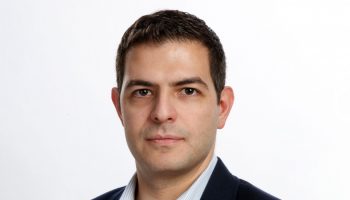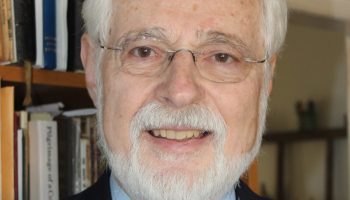The divine speaks through the rhythms and cycles of the natural world, but the message may be lost upon the forest floor. Not all humans are receptive to the messages being portrayed through the whirling winds, the humming birds or bending vines.
Sophfronia Scott, a professor, novelist, essayist and leading contemplative thinker, shared her lecture, “In the Water and the Air: Embracing the Divine Through Nature,” with the Chautauquan audience Thursday, July 7, in the Hall of Philosophy.
Her most recent book, The Seeker and the Monk: Everyday Conversations with Thomas Merton, aligned with Week Two’s theme of “The Wild: Reconnecting with the Natural World.”
Scott first started her career as an award-winning magazine journalist for Time. Some of the books she has written or contributed to include Common Prayer, Love’s Long Line, This Child of Faith: Raising a Spiritual Child in a Secular World, Unforgivable Love and All I Need to Get By.
Beginning with a reflection of her roots in Lorain, Ohio, Scott shared a description of the front lawn of her childhood home. It may have been small, but in her earliest memories, Scott said it felt like a grand meadow.
“I have six siblings, but somehow I managed to spend a good deal of time alone, often outdoors, seeking solitude and sanctuary from a small and noisy house,” Scott said.
She would often gaze upon the green of the yard and the blue of the sky, but one day, Scott saw rays of sunlight seeping from the sky.
“I viewed (the rays) with wonder. No, not only that, I felt it as a living presence. Like one of those rays could lay upon me like a hand on my shoulder. And I don’t know why, but I had this sense that it would follow me everywhere,” Scott said. “Then the cloud shifted. And I couldn’t find it again. But I kept looking for it. I told my mother about it. And I remember this specificity with which I did so, as though I made a new friend.”
This ray of sun, in Scott’s words, was “the seed from which my faith sprouted.” It helped her understand that the divine was all around her.
The title of Scott’s lecture included the word “divine.” She explained that she used it not only because it is beautiful, but also to keep the door open for those who feel like the word “God” may be an obstacle.
Scott said she often returns to a state of remembering her senses of the divine as a child. Often, she remembers naturally and without pressure, but sometimes, she needs to remember to move forward in the digital era.
Quoting from Thursday’s morning lecturer Terry Tempest Williams’ book Erosion: Essays of Undoing, Scott read, “Our connection to the world is virtual, not real. … We have moved ourselves from the outdoors to the indoors. Nature is no longer a force, but a source of images for our screensavers. We sit, we stare, we text on our iPhones and type on our keyboards and await an immediate response. Patience is an endangered species. Intimacy is a threatened landscape.”
Scott shared the words of Fr. Richard Rohr, a previous interfaith lecturer at Chautauqua, who said that the separation of nature and human consciousness must be healed through a radical overcoming.
God is continuously reaching out to humans with tenderness and love through nature, Scott said. But she questioned if humans are listening and paying attention to the messages God sends.
“We live in rhythms and cycles, which is how nature moves,” she said. “That’s how God moves.”
Alice Walker’s novel, The Color Purple, conveys the notion that God wants people to listen to him and notice the fruits of his labor on Earth. Scott quoted an excerpt from Walker’s novel.
“I think it makes God mad if you walk by the color purple in a field somewhere and don’t notice it,” Scott read. “People think pleasing God is all God care about, but any fool living in the world can see it always trying to please us back.”
Scott “met” Merton, the subject of her most recent book, in December 2011 as she read a passage from his book Conjectures of a Guilty Bystander.
“Hearing those words, to put it simply, set my world on fire,” Scott said.
She quoted from the section “The Night Spirit and the Dawn Air.” The story depicted birds of dawn, rather than singing a song, asking a question in chirps. They asked if it was time for them to be, and when they knew it was, they fully awoke in flight and harmony.
“I heard those words. And suddenly, I wanted to be outside at the crack of dawn, eager to hear the sense of the voice of the creator spirit, giving the waking birds that vital message. … I wanted God to tell me it was time to be,” Scott said. “I too wanted to hear and understand the message that Merton goes on to say. He says, ‘Here is an unspeakable secret. Paradise is all around us. And we do not understand.’ I felt something opened up in my whole being. It felt immense and small at the same time. Because it felt like one word: Yes.”
In December 2019 after Scott’s mother died, she traveled to visit the Abbey of Gethsemani, Merton’s Kentucky monastery, in the rain.
“December has become a tough month to navigate,” she said. “The days marked by decline in loss — the anniversary of the Sandy Hook shooting, my father’s final decline, which had begun in December of 1990. The same for two dear friends: Katie in 2017 and Rob in 2019. Now my mother was newly gone.”
The month of December was also tumultuous, yet pivotal, for Merton’s life.
“He had entered the Abbey on Dec. 10, 1941,” Scott said. “In December 1959, he received a discouraging note from Rome, denying his request to move to a Mexican monastery. He died on Dec. 10, 1968.”
Scott’s journey to the Abbey was deeply personal, as Merton’s words illustrated a true reviving of life when describing the nature that surrounded him. But he was not always allowed to be one with nature. In fact, the first eight years of his life at the monastery were spent behind the Abbey’s walls.
“When Merton first arrived, monks were not allowed outside the walls except for work assignments,” Scott said. “His days were spent in cycles of prayer, study and writing. Even today on the monastery’s website, a note to the visitors reads, ‘We ask that you bear in mind that the monastic life is lived as a separation from the world.’ ”
But on June 27, 1949, Merton was unexpectedly granted permission to go into the woods alone to seek solitude and silence.
“On that day, his writing and his spiritual reality changed forever,” Scott said. “It is a known fact that going outside and being in nature is good for us. But what Merton experienced that day went beyond taking a hike and beyond simply stopping to smell the roses. Merton’s heart didn’t soar, profoundly touched, because he took a walk. He felt something out there.”
Embarking on the same path through the woods as Merton, Scott began to feel a similar transcendence, awareness and oneness with creation. She expected to follow the path and return to the monastery in less than an hour, but felt compelled to stay.
“Because I reached my destination, and because it was also cold outside, there was every reason for me to turn back and return to the Abbey as I planned,” Scott said. “But I didn’t move. I was entranced by something I heard, and that sensation was holding me there.”
The Earth began to speak to Scott, and she was listening. She surrendered to the divine silence. She waited for the silent message of permission to be fully alive, just as the birds had during the dawn.
“I have no doubt it was the same silence that Merton enthralled with what he … had called ‘the marvelous quiet.’ I heard it. And it was indeed so stunning that I could only marvel,” Scott said. “It was amazing. How can I be standing in this big open space, sky all around me, and have it be filled with a lovely silence?”
Often, humans look to the weather as a direction of preparation rather than naturally tuning into it.
“(Weather) is Earth’s personality speaking to us,” Scott said. “Each aspect of weather nudges me out of my complacency and says, ‘Look. You are here. Pay attention. The Earth is turning.’ ”
Information about the weather, Scott said, is more accessible than ever before, but the knowledge is often taken for granted. Merton believed humans should have a deep relationship with atmospheric conditions; Scott shared a quote on his beliefs:
“Perhaps we have a deep and legitimate need to know in our entire being what the day is like, to see it and feel it. … I have a real need to know these things because I myself am part of the weather and part of the climate and part of the place,” Scott shared from Merton. “And the day in which I don’t share truly in all this, is no day at all.”
Beyond being within the foliage of nature and understanding the work of the atmosphere, Merton also worked diligently to understand species of animals and plants that shared the same planet as he did. He would observe their behaviors and find natural resilience and strength through their very being. In one instance, he wrote of gardenias blooming after their typical blossoming season was over.
“We learn about unusual circumstances. Merton saw the (gardenia) in the dark and the flower had bloomed in less than ideal conditions,” Scott said. “Therefore, we can take from it a lesson of beauty and resilience.”
Scott recites the names of flowers so she does not forget them. She understands the behavior of cardinals. She works to understand the nature around her to better understand the divine and herself, as she believes they are all interconnected.
Both Merton and Scott believe it is important to understand the small portion of the Earth that one is surrounded by.
“Wherever we live, to be on this planet at all is an extraordinary gift,” she said. “The best way to show our gratitude is to learn as much as we can about where we live. … It is all a part of us.”





